Yea verily, with all that’s come and gone with Erik Buell and his motorcycles, it’s hard to believe only 20 years have transpired since he begat the X1. This was truly a motorcycle that was stealthily sneaking up on being a machine that could compete with some of the best in the world. At that time, Harley-Davidson had just bought up control of Buell Motorcycles. Surely goodness and mercy would follow Buell all the days of his life?
1999 Buell Lightning X1
A Different Way to Dance
Los Angeles, September 27, 1999 — There will always be things we are forced to accept, without explanation. Remember the kid back in high school you could never figure out? He was the one that everyone thought was a dork, but he somehow got invited to all the parties, hung out with the cheerleaders and such. You know, the nerd who would somehow befriended all the jocks and stoners and the rest of the ‘cool’ people. He was just so out-there, so un-cool that he was cool. Even those that didn’t understand him had to accept him.That kid, in this bike’s honor, shall from now on be referred to as Buell. When Erik Buell was at Harley, he helped with the design of some of the first FXR frames.
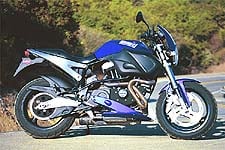
So it was only a natural progression that when he decided to go the sportier route and build something decidedly un-cruiserish, he wedged a Milwaukee-born power plant into his sport frame. As things came along and the bikes took shape, as is often the case, the offspring looked quite like its creator; which is to say, the bike was quite quirky at first. It had a number of cool features that onlookers admired, but it was decidedly homebuilt, in both look and feel. Not much of the quirkiness — or coolness, mind you — has faded since then. So with the 1999 Lightning X1 the legacy continues onward with a number of improvements over the first vehicles that came out of Erik’s garage.
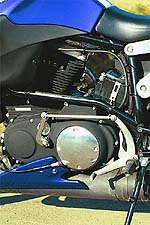
The new bikes are significantly better assembled and, despite one recall as of late, they’ve held up quite well, even under the somewhat substantial girth and ham-fists of our day-to-day test crew. The styling, though, remains a love it or hate it affair. Motorvation still comes in the form of a 1203cc air-cooled, four-stroke, 45° V-twin, with the 1999 iteration getting its oxygen/petrol mixture fed to it by fuel injection as opposed to the carbs found on previous Buells.
The tranny is a well-spaced, five-speed constant-mesh unit with a final drive ratio of 1.6 to 1 that provides positive, though sometimes clunky gear changes. The wheelbase checks in at a stubby 55.0 inches, with 23° of rake and 3.5 inches of trail hanging off the steering stem in the form of Showa inverted forks with both adjustable rebound and compression damping. The rear of the bike still retains the somewhat awkward extension type Showa shock, adjustable for rebound, compression and preload.
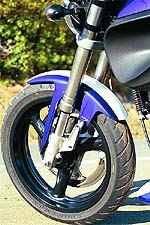
The motor on this bike is rather peppy when you consider it came from a Harley donor. But, when compared to recent Japanese machinery, it lacks in some ways. Despite the fat torque curve of the Buell motor, one of the main complaints with the Buell centered around the narrow power band. The real power spreads from only about 4000 – 6300 RPM. Anything below 3200 rpm and the thing shakes side-to-side like our girlfriend’s heads when we mention sex. Rev it up to above 6300 and its the EFI management system pulls the plug from your bathtub of power. For a sporty bike, this isn’t a wonderful thing as it necessitates an inordinate amount of left foot movement when you should be focusing on the approaching turns.
Again, this is a performance Sportster and not a race bike. Still, we race Buells, but mainly for the same reason others race dogs — ’cause we can. The bike’s ergonomics have come a long ways, though. As a complete package, they’re not the usual Harley fare, but they are by no means 996-esque either.
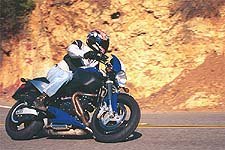
The bars have a reasonable bend to them and the seat is 100-percent better than the version on ’98 Buells. The airbox doesn’t look quite like the bread-box, like on other models, and the X1 seat actually has padding between your ass and the frame’s backbone, which is, like we need to say it, a nice touch. Between the seat and pegs is a decent amount of room, where even staffers in excess of six feet found reasonable comfort. The tank is sculpted quite nicely as well, with decent indents for the knees, though when the bars are turned to full right lock, the thumb grazes the tank.
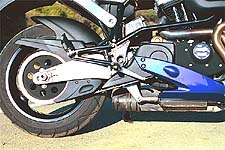
This is presumably due to the larger grip needed to accommodate the throttle pipe and only a minor niggling trait, which is part of the love, and curse, of Buells anyway. Riding the bike is, at first, a bit of an unusual experience. It’s one of those times in life where you almost dread doing something but, once you’re in the process you find yourself smiling. This bike’s domain is a twisty back-road comprised of mostly second and third gear turns. Use the motor correctly and it will tug out of corners nicely. When slowing for the next corner, however, tug on the front brake lever and the single 340 mm disk and the six-piston caliper will stop you.

When you push the bike hard, you start to feel the front suspension bottom over braking bumps and the chassis become unsettled by mid-corner bumps. Cranking on the suspension clickers was somewhat pro-active in getting rid of these handling traits, though we suspect some of the cause stems from the bike’s 440 lbs dry weight. Though, since it’s set up to be an all-around machine, this is not a surprise, and when this is taken into consideration, the back-road handling seems rather impressive.When the ride’s over, you sit back pondering what just happened, and you can’t quite put your finger on the cause of smile on your mug. You just know that, as a whole, you enjoyed the experience and you’d like to have an encore performance.
Maybe, but you’re not sure when because, for all the things this bike does well, and for all the steps forward it has taken recently, it is still, after all, a quirky creation. It’s a tough bike to place into a niche. It’s not really a sportbike when compared to an R1, or even a CBR600F4 for that matter.
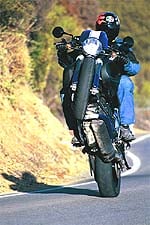
“The back-road handling seems rather impressive.”
And as a standard, well, she’s a little bit too edgy and aggressive for that category of sedate round-towners, what with the funky styling, inverted forks, raspy motor and what-not. It’s too sporty for a few of the Harley guys, and some sportbike guys think it’s too Harley to be a sport-bike. Whatever. This Lightning will surprise a lot of people if given half a chance. Unfortunately, many of these bikes seem destined to live in a two-bike garage: One where there already exists a Harley cruiser and the owner feels a need for a secondary, speedier ride. But, since most Harley guys are such ‘purists’ and will not ride anything without a Cheeseland pedigree, Japanese bikes are out of the question and the Buell dealer’s phone starts ringing. That’s too bad for the closed minded people, because when a good rider is on-board the Buell and passes someone on a Japanese crotch-rocket; well, who’s feeling quirky now?
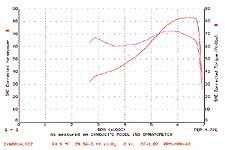
Specifications:
Manufacturer: Buell
Model: X1 Lightning
Price: $10,599 MSRP
Engine: Air cooled, Four-Stroke, 45 degree V-Twin
Compression ratio: 10:1
Bore and Stroke: 3.5 X 3.8 in./ 88.8 X 96.8 mm
Displacement: 1203 cc
Fuel Delivery: Dynamic Digital Fuel Injection (DDFI)
Transmission: Five-speed, constant mesh
Tires/Front: Dunlop, 120/70 ZR 17 D204
Tires/Rear: Dunlop, 170/60 SR 17 D204
Wheelbase: 55.0 in./139.7 cm
Fuel Capacity: 4.6 gal. (low fuel light at .4 gal.)/ 17.41 L (low fuel light at 1.51 L)
Claimed Dry Weight: 440 lbs./199.58 kg
The post Church of MO: 1999 Buell Lightning X1 appeared first on Motorcycle.com.
【Top 10 Malaysia & Singapore Most Beautiful Girls】Have you follow?